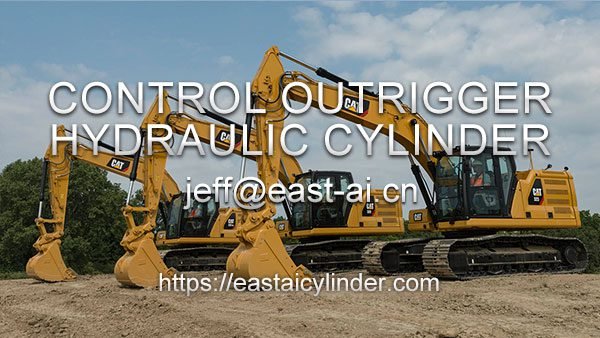Excavators: An In-Depth Guide
Excavators are a cornerstone of modern construction, mining, and other heavy-duty industries. Their versatility and power make them indispensable for a wide range of tasks, including digging, lifting, and moving heavy materials. However, to fully appreciate the value of an excavator, it’s crucial to understand the differences between excavators and bulldozers, the main types of excavators, and their key components—including hydraulic cylinders, which play a critical role in their operation. This article delves into these aspects in detail, providing a comprehensive guide to excavators.
Excavators vs. Bulldozers: Key Differences
At first glance, both excavators and bulldozers are massive pieces of machinery designed for earth-moving tasks. However, they are engineered for different purposes and have distinct functionalities:
Primary Function
Excavators are primarily used for digging and lifting tasks. They feature a long arm (known as the boom) with a bucket at the end, enabling them to excavate deep into the ground or lift heavy objects. In contrast, bulldozers are designed to push large quantities of soil, sand, or debris. They are equipped with a wide, flat blade at the front, which is used to level ground, clear obstacles, and push materials.
Mobility and Rotation
One of the standout features of excavators is their ability to rotate 360 degrees on their base. This capability allows for greater flexibility and precision when digging or moving materials. Excavators typically move on tracks, which provide stability on uneven or soft ground. Bulldozers, while also moving on tracks, do not have the same rotational capability. They are designed to move forward and backward, with their main task being to push materials rather than lift or dig.
Versatility
Excavators are highly versatile machines. They can be equipped with a variety of attachments beyond the standard bucket, such as hydraulic hammers, augers, grapples, and shears, allowing them to perform a wide range of tasks, from breaking rock to tree removal. Bulldozers, although powerful, are more specialized. Their primary function remains earthmoving, though they can be fitted with rippers and other attachments for specific tasks.
Precision vs. Power
Excavators are known for their precision. Their hydraulic systems allow for smooth and controlled movements, making them ideal for tasks requiring accuracy, such as trenching or fine grading. Bulldozers, on the other hand, are brute-force machines. They are designed to move large volumes of material quickly and efficiently, which makes them ideal for clearing land or preparing a site for construction.
Two Main Types of Excavators
Excavators come in various types, each designed to meet specific needs. The two most common types are crawler excavators and wheeled excavators:
Crawler Excavators
Crawler excavators are the most prevalent type of excavator. They are equipped with tracks instead of wheels, which provide excellent stability and allow them to traverse rough or uneven terrain with ease. The tracks distribute the machine’s weight evenly, reducing ground pressure and preventing it from sinking into soft ground. This makes crawler excavators ideal for heavy-duty tasks such as trenching, mining, and large-scale excavation. Their versatility extends to various attachments, enabling them to tackle tasks ranging from digging foundations to demolishing structures.
Wheeled Excavators
Wheeled excavators, as the name suggests, move on wheels rather than tracks. This design makes them faster and more mobile, especially on paved roads or in urban environments. Wheeled excavators are often used in situations where speed and maneuverability are critical, such as in road construction, material handling, and utility work. However, they are less stable on uneven or loose ground compared to crawler excavators. To compensate, wheeled excavators are often equipped with outriggers, which can be extended to stabilize the machine during operation.
Detailed Breakdown of Excavator Components
Understanding the various components of an excavator is key to appreciating how these machines function and the role each part plays in their overall operation. Below is a detailed exploration of the essential components, with a focus on the hydraulic system and cylinders.
Boom
The boom is the long arm that extends from the excavator’s main body and connects to the stick (or dipper arm). It serves as the primary reach mechanism, allowing the machine to extend outward and downward into the ground. The boom is pivotal in digging and lifting operations, providing the necessary range of motion.
Stick (Dipper Arm)
Attached to the end of the boom, the stick extends the excavator’s reach even further and connects directly to the bucket. The length of the stick can vary depending on the application; a longer stick provides greater reach, while a shorter stick offers more power and control for heavy lifting.
Bucket
The bucket is one of the most critical attachments on an excavator. It is used for digging, scooping, and lifting materials such as soil, rock, and debris. Buckets come in various sizes and shapes, depending on the task at hand. For example, trenching buckets are narrow and deep, while grading buckets are wider and used for smoothing surfaces.
Cab
The cab is the operator’s compartment, where all controls are housed. Modern excavator cabs are designed with ergonomics and safety in mind. They are typically enclosed to protect the operator from the elements and debris, and many are equipped with climate control, advanced monitoring systems, and even noise-canceling technology to enhance operator comfort.
Engine
The engine powers the entire machine, providing the energy needed to operate the hydraulic system and move the excavator. Most modern excavators are equipped with diesel engines, known for their durability and high torque output. The engine’s power output directly affects the excavator’s performance, especially in heavy-duty tasks.
Hydraulic System
The hydraulic system is the heart of the excavator, driving the movement of the boom, stick, bucket, and other attachments. It operates on the principle of fluid power, where hydraulic fluid is pumped through a series of valves and cylinders to generate movement. The hydraulic system is what gives the excavator its smooth, precise, and powerful movements.
Hydraulic Cylinders
A key component within the hydraulic system, hydraulic cylinders are responsible for converting the hydraulic energy into mechanical force. In an excavator, hydraulic cylinders are used to move the boom, stick, and bucket. Each cylinder is composed of a tube, piston, and rod. When hydraulic fluid is pumped into the cylinder, it pushes the piston, causing the rod to extend or retract, thereby moving the attached component. The size and power of the hydraulic cylinders determine the lifting capacity and reach of the excavator.
Undercarriage
The undercarriage is the lower part of the excavator, comprising the tracks or wheels, drive system, and the framework that supports the upper structure. In crawler excavators, the undercarriage is fitted with tracks, which provide stability and allow the machine to move over various terrains. In wheeled excavators, the undercarriage includes the wheels and often stabilizing outriggers.
Counterweight
The counterweight is a heavy mass located at the rear of the excavator’s upper structure. It is designed to balance the machine, counteracting the weight of the boom and any attachments, preventing the excavator from tipping forward during operation. The size of the counterweight can vary depending on the size of the excavator and the tasks it is designed to perform.
Swing Mechanism
The swing mechanism allows the excavator’s upper structure to rotate 360 degrees. This capability is crucial for the excavator’s versatility, enabling it to dig, lift, and move materials without needing to reposition the entire machine. The swing mechanism is powered by a hydraulic motor, which is controlled from the cab.
Control System
Modern excavators are equipped with sophisticated control systems that allow the operator to perform precise movements with ease. These systems include joysticks, pedals, and various levers that control the boom, stick, bucket, and machine movement. Advanced excavators may also include computerized controls, which allow for automated functions, monitoring, and diagnostics.
The Role of Hydraulic Cylinders in Excavator Operation
Hydraulic cylinders are among the most critical components in an excavator, responsible for the powerful and precise movements that these machines are known for. Here’s a closer look at how they function and why they are so essential:
Basic Functionality
Hydraulic cylinders work by converting the hydraulic pressure generated by the pump into mechanical force. This is achieved through the movement of hydraulic fluid within the cylinder. When the operator activates a control, hydraulic fluid is directed into one side of the cylinder, pushing the piston and extending the rod. This action moves the attached component, such as the boom or bucket. To retract the rod, the fluid is directed to the opposite side of the piston, pulling it back.
Types of Hydraulic Cylinders
Excavators use two main types of hydraulic cylinders: single-acting and double-acting. Single-acting cylinders only allow the piston to move in one direction, with an external force (such as gravity) required to return it to its original position. Double-acting cylinders, which are more common in excavators, allow the piston to move in both directions, providing greater control and versatility.
Placement and Role
Hydraulic cylinders are strategically placed on the excavator to control the movement of the boom, stick, and bucket. The boom cylinder is typically the largest and most powerful, as it must lift the entire boom and any load it carries. The stick cylinder controls the movement of the stick, providing additional reach.
Excavators are indispensable machines in the construction and heavy-duty industries, offering unmatched versatility, precision, and power. By understanding the key differences between excavators and bulldozers, the main types of excavators, and their crucial components—especially the role of hydraulic cylinders—one can fully appreciate their significance in various applications. Whether it’s digging trenches, lifting heavy loads, or demolishing structures, the intricate design and engineering of excavators make them essential tools for efficiently tackling complex tasks in challenging environments.


